This CE Center article is no longer eligible for receiving credits.
Over the last decade, new techniques in controlling elevators have radically changed thinking about how building mobility is organized and operated. For architects, these advances are essential knowledge for designing and renovating any buildings that rely on elevators for moving their occupants and visitors. The most important advancement in recent years is destination control. About 20 years ago, destination control systems were commercialized based on this approach. Not only did the controls reduce wait times and traveling times by up to 30 percent, but they also allowed for new techniques in core layouts, elevator stacking, and overall building designs.
From the 1940s to today, elevator call systems have operated on a single, uniform principle, the up-and-down hall push-button. These systems are known today as conventional technology. Used to guide elevators and tell them which floor to visit next, this approach is familiar to anyone who regularly rides an elevator. The essential logic is:
- A car will continue traveling in the current direction as long as there are remaining requests in that direction.
- If there are no requests in that direction, the car should wait and idle.
- The car should change direction if there are requests in the opposite direction.
Decidedly simple, yes—but elevator operations could be optimized for even greater efficiency. In the 1980s, microprocessor technology introduced programs with more complex commands. These include heuristics—experience-based problem solving—which attempts to approximate reasonable if not optimal solutions to handling requests. These more recent algorithms are typically applied to elevator banks through a lift-group control system (LGCS), using microprocessor logic to send off the most appropriate car among the group to answer a given request.
Yet older conventional technology systems can be outdated and inefficient. These systems represent unnecessary costs and losses to both building owners and tenants. Simple and heuristic algorithms often waste time, energy, money, and space in a large number of typologies and applications. For architects and their clients, there are big implications for adopting cutting-edge controls instead—creating “smart elevators” that benefit everyone.
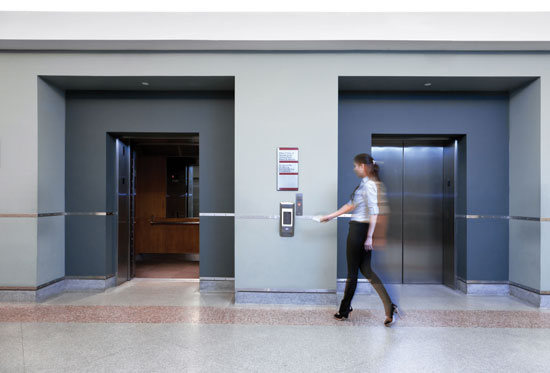 |
Elevator layouts traditionally are dictated by efficiency of core area and ADA rules, but destination-based systems remove this design constraint,
allowing more freedom in planning a lobby layout.
Photo courtesy of Schindler Elevator Corporation |
Destination Dispatch
Being an amenity for building convenience, elevators are more than just vertical transportation. Its performance is a real factor in setting rental prices and attracting and retaining tenants for office buildings or buyers of condominiums. They are a memorable part of our visits to hotels and conventions. Although elevators are inherently energy efficient due to their counterbalancing, elevator systems do use significant energy during operation, and this can be bad for the triple bottom line of social, economic and environmental sustainability. Additionally, elevators consume floor area for each story served—square footage that can't be used for any other purpose.
With the goal of making elevators more efficient in each of these respects, designers are frequently looking to a computer-based system of destination control, a smart elevator technology often called destination dispatch.
The essence of destination dispatch is the premise that the user of a multi-elevator installation alerts the system to his or her intended destination before entering the car. This feature alone improves on the heuristic algorithms, by enabling the LGCS to group riders together who are traveling to the same destination. But the potential is great for destination dispatch to improve the building mobility experience—reaching beyond performance improvements alone.
User Experience
For example, user convenience and experience can be enhanced, making destination dispatch an amenity in its own right. It is less likely to strain the user's wait-time tolerance. Each input device is position knowledgeable, so devices can be placed throughout the path of travel to allow the user's walk time to the elevator to become part of the waiting time, for example. Some destination dispatch systems have the capacity for personalizing aspects of the ride to the individual user through use of RFID or pin code technology.
Building Performance
Performance improvements also benefit bottom-line property financials. Fewer trips and fewer stops can translate to reduced energy requirements, which translate directly to savings on power consumption and reduced carbon emissions. Destination dispatch systems can provide heightened security and access control. This is especially true for security programs and building automation system (BAS) devices engaged in data collection and analysis, which can provide a level of access control that elevators equipped with keyed access systems cannot.
Personalized for Occupants
Such personalizing dispatch systems are poised to significantly alter the elevator control paradigm over the next decade. Stored user data can also be shared with other BAS networks, creating opportunities for “smarter buildings” that demonstrate improved performance in myriad ways. This is true for new construction projects and existing systems in need of modernization, in both high-rise and mid-rise settings across a wide range of typologies.
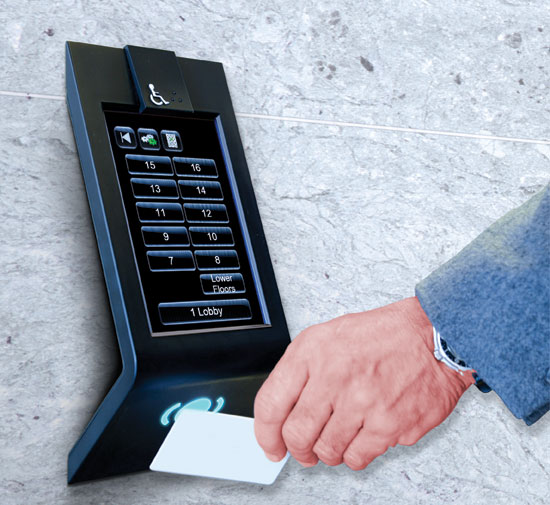 |
Elevator dispatch systems can be personalized to allow for a number of special functions, storing user data to allow for certain types of access,
special elevator privileges, or for sharing with other BAS networks.
Photo courtesy of Schindler Elevator Corporation |
Evolving Elevator Controls
Old-fashioned car-switch levers recall uniformed lift attendants and movies of a certain period. A few vestiges remain in big American cities, but not by design. Such controls are antiquated, but perhaps no more so than conventional up-and-down push-button controls will seem to be in the near future.
One of the first collective push-button control systems introduced into the marketplace dates back to 1909. The first automatic signal control in 1924 introduced electrical relay logic boards into the pantheon of lift control technology.
Microprocessor-based controls emerged in the late 1970s in Germany, Japan, and the United States, with systems that monitored every aspect of elevator operation. Most noteworthy was their ability—now standard—to gather and analyze data from sensors indicating car positions, moving directions, loads, and door status, as well as summaries of hall and car calls, runs per car, alarms, and more. Systems used a single, computer-based system and gave rise to remote elevator monitoring.
Next came destination-dispatch technology, introduced in 1992. “Back in those days it was relatively a hard sell,” says Bill Lippman, vice president, modernization sales and destination technology, for Schindler Elevator Corporation. “The first system was the only one on the market, and it was relegated to high-rise commercial office environments almost exclusively.” User controls for the product consisted of a numbered keypad, which the rider employed to input the destination floor. The LGCS, using a destination-dispatch algorithm, directed riders travelling to the same floor (or to floors near to one another) to enter a particular car.
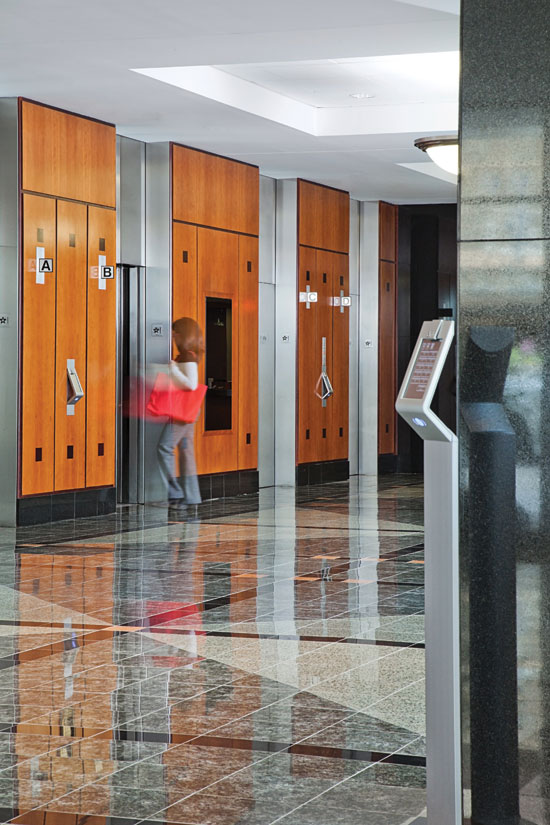 |
Computer-based elevator destination control systems allow users to indicate their destination before entering the car.
Photo courtesy of Schindler Elevator Corporation |
Today there is a robust, competitive marketplace for elevator systems incorporating some form of destination-dispatch technology, with seven or more manufacturers and as many proprietary products. Applications are seen in universities, hotels, apartment buildings, and corporate headquarters, among others. The surge in research and development and market positioning largely reflects the measurable return on investment (ROI) associated with application of destination dispatch. Leading property managers and owners say it's likely to be the next paradigm in urban mobility solutions.
More recent developments in the control technology include second-generation destination dispatch control algorithms, introduced around 2004, that improve performance in all traffic modes, further reducing wait times and destination times. The addition of access-card readers to the user control panel further builds on the ideas of personalization and customized service. With a simple swipe, the controls recognize the user and floors available. The added level of security using access cards has also expanded interest among end-users. Visitors or contractors to a facility, for example, are issued cards in lobby or reception areas.
These and other emerging personalization features, we will discuss in detail, are among the most intriguing and beneficial advances for elevator end-users and owners who invest in destination-based elevator controls. Overall, the ROI is being studied by interested owner groups. One market report by CoStar, a commercial real estate information clearinghouse, found that buildings with destination-based elevator controls earn an average of $3.50 more per square foot than comparable properties without the advanced controls. Far from being relegated to only high-rise office, today destination-dispatch systems are making inroads into:
- Class A office
- Hotels
- Healthcare
- High-rise residential
- Government
- Academic
Midrise structures benefit from the technology also, as do unexpected typologies such as senior living facilities. As the technology becomes more widely available, more building owners and facility managers will be learning about destination controls to stay competitive.
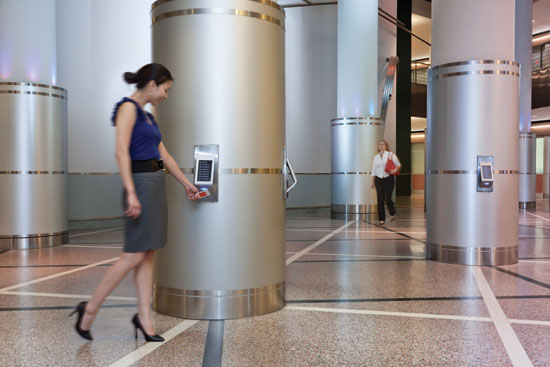 |
The addition of access-card readers to the user control panel allows customized service.
Photo courtesy of Schindler Elevator Corporation |
That means that project teams need to learn how to design for it. This will require familiarity with the system's effect on building traffic patterns and floor layouts and areas of use, as well as the particulars of the elevator and controls technologies.
| New Construction, Residential |
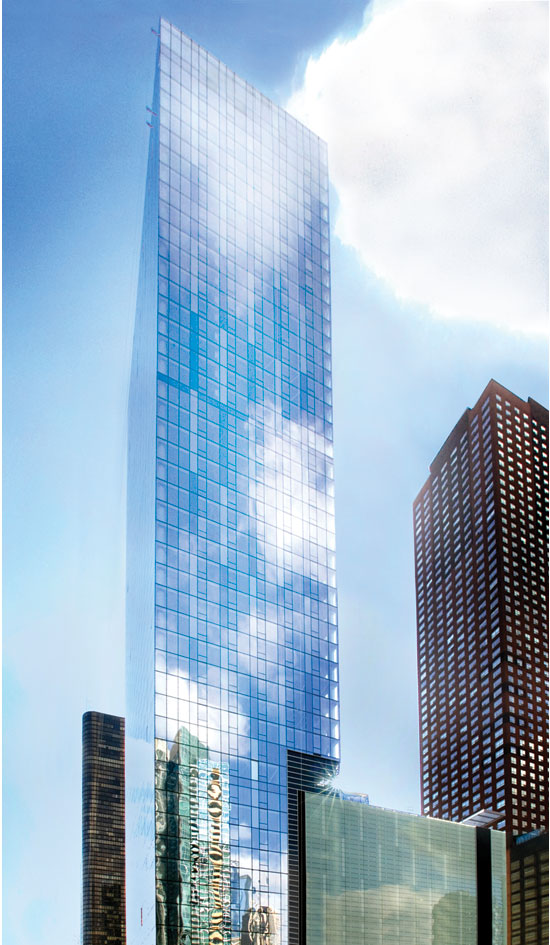 |
The developer and
architect employed destination-based controls to help meet customization, security, and efficiency goals.
Photo courtesy of Schindler Elevator Corporation |
For the 45-story, 500-unit luxury rental tower at 516 North Lake Shore Drive in Chicago, real estate development company Related Midwest opted for a fully integrated destination-dispatch system to upgrade the elevator systems. The developer wanted more than a hall-call system; in order to attract top-dollar tenants, it sought a system that would provide high-level command and communication features.
Designed by Solomon Cordwell Buenz, the building is on track to achieve LEED Silver certification. Adding to the energy-efficient building elements is a combination of permanent magnet elevator motors combined with destination-based controls. The system also gives building management tools to develop applications for meeting target efficiency goals, updating security protocols, and adapting to tenants’ specialized needs. This destination dispatch system, equipped with the full range of personalization features, not only optimizes operational performance and energy efficiency but adds a high level of customization.
Related’s president Curt Bailey says, “The convenience and luxury this new system will offer our residents are fundamental to the high standard of living we provide.”
|
Implications for New Construction
Beyond these benefits for building occupants and owners, there are new trends in architectural design that leverage and exploit the technology. In project pre-planning and schematic design, studies of intended elevator usage and user behaviors should be considered in developing the core design and circulation scheme. User data can be analyzed and weighed against factors such as building code limits on elevator car speed; the results will inform such choices as core and bank layouts, number of elevator shafts and cars, as well as shaft heights, express and skip-stop options, as well as dedicated elevators for specific uses or occupants.
Incorporating destination-dispatch models into project planning can alter the potential design results. Alterations both subtle and radical represent increased architectural flexibility to improve upon delivery of project goals, including the following areas:
Traffic patterns. Typical elevator designs are based on up peak roundtrip time calculations, which describe the volume handled during a peak in trips up the elevators—for example, a morning rush-hour or post-lunchtime maximum in an office building. These trip times usually do not include the time end-users spend waiting alone or in clusters for the next car.
Unlike standard two-button controls, a destination control terminal assigns a particular car to each rider, alerting them as to which car will serve them. This allows the building designers more latitude in where elevator shafts are located: elevators and elevator banks can be spaced farther from one another, if desired, to separate uses—a hotel and condominium, for example—or so they are better positioned to serve the layout needs of upper floors. The elevator control interface can be located centrally, which then directs the user to a specific car—by letter, for example—among multiple banks.
Dispersing riders among various banks and cars also eases flow of traffic and crowding. The data collection and analysis capabilities of some destination-dispatch systems can also adjust the elevator response to new patterns. For instance, some high-traffic floors may require destination-based dispatching more than others, simply based on the particular occupant's business. The control system can be reprogrammed to suit these needs, which frees the architectural design team from having to predict changing use patterns.
“These options also improve circulation flow and the way users move through buildings while providing more efficiency for the building owner,” says Schindler's Lippman. “With today's personalization and access capabilities, buildings in general have better handling capacities, lower overall wait times and lower traffic times in all modes: up peak, down peak, interfloor and the like.”
Lobby layout and lift planning. Elevator layouts have traditionally been dictated by efficiency of core area, user proximity, and accessibility requirements such as the Americans with Disabilities Act Accessibility Guidelines (ADAAG). With this in mind, a four-elevator bank should stand two-facing-two. This is only logical: Having three or four or more cars in line would downgrade service by requiring longer door-hold times to comply with local codes, ADAAG and other accessibility requirements.
Replacing conventional controls with destination-based systems removes this design constraint, offering architects the freedom to plan the best layout for achieving the client's other project objectives. It may be that the client wishes to offer VIP tenants a private waiting area, or that having 10 elevator cars in-line delivers some desired layout need or visual impact. Destination dispatch more easily accommodates these design options, rendering old rules-of-thumb for lift planning nearly obsolete.
Stacking. Destination-based controls, being readily programmable, adjust to serve tenants occupying multiple floors.
Stacked office floors, for example, can be grouped to dedicate a car or cars to serve those floors at peak times. Likewise, a floor that serves multiple uses benefits from the control system's pre-programmed understanding of the traffic patterns, security protocols, priority riders and more. These features leave the design team free to program the floor space, unencumbered by the task of imagining configurations of tenants and space usage.
Operational flexibility and adaptation. Building owners tend to be acutely aware of future uses for their facilities as organizational and market conditions evolve. Many owners value buildings that are easily repurposed.
The flexibility inherent in the destination-based control system eases adapting to new building uses downstream. Commercial space could potentially be converted to residential space, for instance, with virtually zero alteration to the vertical transportation footprint. This flexibility eases or eliminates many limitations of elevator layout for the design team.
| Phased Modernization, Office |
The Crescent, a massive office complex in Dallas exceeding 1.1 million square feet, boasts an impressive 50 elevators and six escalators. A prestige location, the Crescent houses the Dallas-Fort Worth area offices of major investment banks and financial firms.
Composed of a 19-story central tower and two 18-story wing towers, the complex’s modernization requirements included a phased approach, thereby inconveniencing as few tenants as possible at any one time. In addition to new regenerative drives, the updated elevator system will also feature destination dispatch, which users will operate with individual RFID badges. The software identifies the passengers, and attempts to learn their typical movement patterns throughout the complex, in order to offer efficient, personalized service.
The Crescent’s management, mindful of the possibility that they could be faced with modernization again in the future, is particularly appreciative of the system’s adaptability. “We are not just buying an elevator modernization for today,” says Rick Flusche, an assistant operations manager. “But a system for the future, one that is scalable and expandable.”
 |
The Crescent, a large Dallas office complex with 50 elevators, incorporated destination-dispatch elevator controls as part of a phased retrofit. Users operate the elevators with programmed RFID badges.
Photo courtesy of Schindler Elevator Corporation |
|
Aesthetics and impact. A feature particular to destination dispatch technology is the hall call interface, the keypad or touchscreen panels that are used by occupants to enter desired floor numbers. Whether a numeric keypad or the more sophisticated touchscreen, this interface represents an important “touchpoint” or point of contact for occupants and visitors.
Presenting a seldom-seen feature such as a generic keypad or addressable touchscreen currently offers a sense of value that many building owners like to capitalize on. High-tech companies, for example, like how the interface reflects their embrace of the latest technologies. The interface may someday become the norm, but for now it lends an air of prestige to the finished project. This is especially true for the touchscreen-type interfaces, which can be customized to suit the client's taste and goals. For corporate clients, the elevator display screen can be branded with the identity and messages used in other facets of operations. Yet, even a basic interface for destination dispatch connotes a modern, up-to-date facility.
Destination dispatch, though not a panacea for traffic flow, space planning and core layouts, offers a number of design benefits over non- destination controls. There are cautions for the designer as well, explored later in this article, but overall it is a valuable boost to architectural design, freedom and flexibility.
Improving Efficiency and Sustainability
Energy use, operational efficiency and overall sustainability are major concerns for all project stakeholders. Destination-based elevator control systems contribute to these top-level objectives, and offer other, more subtle efficiencies as well.
Because types of elevators, drives, braking systems, and typical traffic patterns vary from facility to facility, it may be difficult to establish a baseline from which to judge efficiency improvements. So it is useful to consider the change in performance after installation in a modernization or retrofit project context. This allows us to compare the effect of a new control system when applied to an existing lift group.
Energy Efficiency
Energy consumption among differing elevator configurations can be quite wide. Consider a modest low-rise set-up: A single hydraulic elevator in a three-story office building might average 3,800 kilowatt-hours (kWh) annually, comparable to four months of electrical consumption in the typical American home, according to one manufacturer. A traction elevator in a 10-story midrise uses closer to 21,000 kWh; in a 30-story high-rise, the figure closes in on 44,000 kWh, rivaling the annual consumption of four typical American homes.
Destination-dispatch systems attempt to reduce energy requirements in a number of ways, including by resolving a demand situation based on the elevators' configuration and design, as well as on actual traffic patterns at the time of use. In general, for example, elevators operate at optimal efficiency in both directions when at 40 percent of capacity. In addition, as intuition would suggest, cars will be more efficient going up empty – and going down full.
Destination-based controls weigh these efficiencies against one another to not only optimize travel and wait times but also to achieve maximum energy efficiency by attempting to average the desired percentage of car capacity. User-entered destination information helps gauge weight or load capacity. But what if two or three unassigned riders enter the car with the user who entered the destination floor? In some cases, the elevator systems include onboard volumetric sensors and other methods for acquiring more complete data; these also allow the cars to report to the central controls that a car is at or near capacity, so that alternate cars are assigned for new hall requests.
| Phased Modernization, Midrise Office |
“Our tenants love it, because they don’t have to push a button,” boasts Don Carter, principal of Raleigh Development Co., which owns the Capital Bank Plaza in Raleigh, North Carolina.
The elimination of button-pushing is the result of Carter’s exhaustive research into controls technology, which led him to choose an advanced destination dispatch system to replace the existing controls on the building’s 40-year-old elevators.
The 14-story building serves an estimated 700 elevator riders each day, many of whom no longer even need to touch the control panel, having RFID badges that identify them to the system and call a car to take them to their destination floor. Visitors without badges enjoy the experience of interacting with a sleek, tablet-style touchscreen panel; riders with badges who wish to travel to a floor other than their usual do so through the same panel.
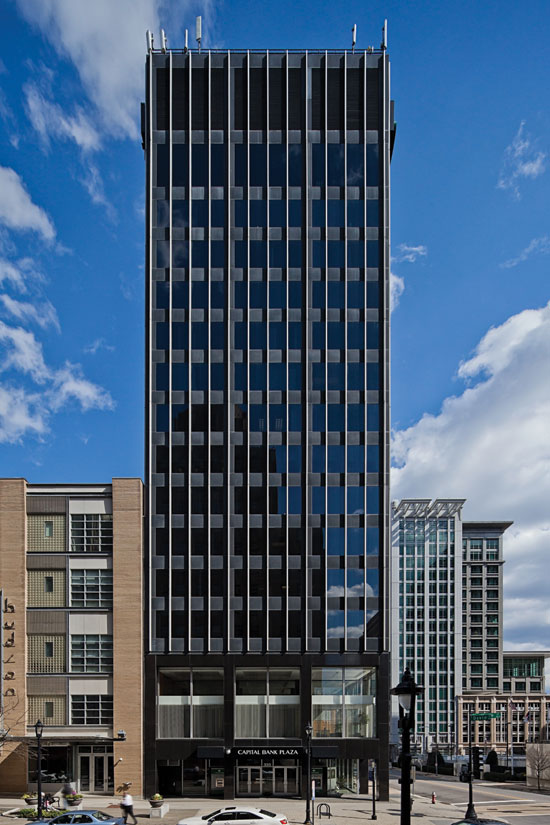 |
Capital Bank Plaza in Raleigh, N.C., eliminated button-pushing for elevators for the building’s 700 riders per day. RFID badges identify occupants
and call cars to take them to their destination floors. Visitors use a tablet-style touchscreen.
Photo courtesy of Schindler Elevator Corporation |
|
Yet the controls are not always programmed for energy use alone. “Destination-based controls opt for getting the riders to their destination as quickly as possible,” says Lippman. “In lighter traffic times, that may not be the most energy-efficient operation. To counteract this, the system can include an eco-mode that adapts acceptable wait times to the current traffic pattern. Fine-tuning this to the needs of the building will produce the optimal balance.”
Comparisons of the smart elevators as compared to systems not using destination dispatch give an idea of possible gains in energy efficiency. According to the building management firm Golub & Co., the new control products cut elevator-related energy consumption by about 23 percent at 680 North Lake Shore Drive in Chicago, a 29-story mixed-use building. In this case the new system was first interfaced to existing controllers, says Golub's general manager Tim Conway, which took only one weekend for the front-end installation. Estimating based on generic figures for a 30-story building, this represents annual savings per car of more than $1,000 (at $0.10 per kWh) and a reduction in carbon emissions equivalent to the consumption of nearly 800 gallons of gasoline.
Operational Efficiency
The modernization has also improved operations at the Chicago property. “We've done some traffic studies with wait time and destination time,” says Conway, “and those have improved closer to 50 percent.” This notable improvement can be extrapolated for even better outcomes in new construction projects, where the entire elevator core and floor plan are designed with destination-dispatch features in mind.
“With destination dispatch, each car makes fewer intermediate starts and stops,” says Lippman. “Loading and unloading is expedited through the assignment of users to cars. All of this reduces time spent in transit for the user.”
The retrofit market is ripe with opportunity for such improvements. For example, the Marriott Marquis hotel near New York City's Times Square adopted an earlier version of destination dispatch in 2006. The main goal was performance improvements in guest experience, which was badly needed. “There were never enough elevators,” recalls Mike Stengel, general manager and area vice president of New York City Marriott. The hotel received an average of five complaint letters each week about lengthy elevator wait times. Stengel responded with apologies and offers of free dinners and other appeasements to hotel guests claiming wait times of up to 30 minutes.
The project team predicted a 15 percent to 20 percent increase in efficiency, and the estimates were surpassed. The entire modernization, including conversion of some service cars to guest cars, improved the system's efficiency by about 50 percent once fully implemented, as reported by SmartPlanet.com. “I have not gotten one elevator complaint letter since we turned them on,” says Stengel. “It was like shutting off a faucet.”1
Benefits for Owners and Users
Stories like the Marriott modernization underscore the value inherent in the latest generation of destination-dispatch elevators that enhance not just their own performance, but occupant experience and owner satisfaction, too. For the most part, these features are dependent upon gathering data on users and personalizing service to the individual user.
Personalization
Next-generation personalization approaches expand the technology to encompass varied command and communication functions. Analytic programming and predictive software are integrated into these highly customized systems to further enhance traffic flow and operational performance of the elevators. Based on positioning of the keypad or touchscreen in the path of travel, the controls begin to dispatch a car before the user has even reached the elevator lobby. Some potential features of such a system include:
- Predictive call entry. This displays the users most likely destinations on the control panel, based on previous behaviors and on current time and location.
- Pre-programmed operation. Programming a card for specific destinations doubles as a convenience and a security feature.
- Contextual operation. This generates the user's list of potential destinations based on the current floor (above the lobby). Examples include the multiple office floors leased by a single company or secure floors of a facility.
- Touchless operation. The user holds the card to the reader, until the display panel indicates or highlights the desired destination.
These features help improve performance—wait and travel times, handling capacity, etc.—while simultaneously improving the user experience. The card reader can interact with the building's card-access security system, providing automatic destination call service at the lobby barrier point, or it can stand alone at the elevator lobby. Either way, the system can store, analyze and leverage user data to continue to improve performance results.
Security and Safety
A comprehensive destination-based system that uses card readers at call stations can easily interface with most building security protocols. This means that the owner enjoys increased security, and can also mean that the user enjoys a safer building environment. Security features of dispatch systems mostly center on the question of access, and mainly address issues of entry at the lobby barrier:
- Elevator assignment. Card reader at barrier provides entry and automatically assigns a car.
- Forward credentialing. Invalidates card if it is not used when required for access. (User must return to lobby or other security point to reactivate card.)
Customization
It is also possible to add another level of features to cater to building occupancies and tenants looking for a high-end approach to the on-site experience for employees, visitors or guests. These customization features and protocols are designed to ease user movement through the building, reduce or eliminate concerns over wait times and access, and enhance the building environment in ways that bring added functionality or revenue to the owner.
| Renovation/Retrofit, Health Insurance |
“This 12-story building moves as many tenants as some skyscrapers,” noted Steve Evans, Humana workplace solutions associate, about Humana’s Waterside Building in Louisville, Kentucky. The heavy demand on the building’s elevators prompted the stakeholders to seek an efficient controls solution for this midrise.
Humana Waterside was the first adopter of a novel destination-dispatch technology in the United States. Humana leadership liked the risk profile: They would be able to investigate the movement patterns of Humana associates through the control system’s built-in applications. Even better would be the 250% estimated improvement in performance and efficiency, and wait-times reduced by 75%—from 2 minutes to 30 seconds.
“Our associates get much more than just an elevator ride,” adds Evans. “They get a journey, moving and experiencing their environment with more comfort and efficiency than ever before.”
|
Depending on the situation, a building occupant may have a cab preference or a need for additional time to enter the cab. (In some cases, the user may simply desire more space.) Programming the user profile to represent these needs helps assure the positive experience. Some manufacturers also offer additional control and call options, such as call panels installed in remote spaces, such as private offices, and even apps for smartphones or personal digital devices that interact directly with the destination dispatch system, allowing the user to alert the system of arrival time or interfloor travel needs.
A system can also be programmed to assign cars based on organizational structures or personal requirements. Doctors and medical staff in a hospital, for example – may need to have special access privileges or increased privacy as they ride. Some real estate executives see personalized access to a private or semi-private car as a way to encourage high-profile tenants to sign or renew their leases.
Additionally, destination-based systems can even be used to create personalized audio-visual experiences in the cab. Rather than listen to Muzak, riders may be treated to a favorite song, a news story relevant to their company or personal interests, an advertisement of specials in the cafeteria, and much more. This not only enhances the user experience, but also can create opportunities for intra-building synergy. In mixed-use buildings, the owner could conceivably earn revenue from retail and food service tenants who want to advertise to the rest of the user population. By the same token, the user could personalize his experience to eliminate certain advertisements (or all of them), which, in fact, makes the advertising more effective, by presenting it only to users who are amenable.
Planning for Elevator Projects
Before beginning a discussion of using destination dispatch as a component of modernization, retrofit and renovation projects, it is worthwhile to note a few common questions and concerns about the technology. These factors bear directly on the questions of whether or not to incorporate one of these systems into a design—or to suggest that a client do so.
Technologies are Distinct
Specification issues arise in the adoption of any control technology. In the case of destination-dispatch elevators, the platforms and manufacturers are not equivalent, so care must be taken when attempting to secure competitive bids and issue “or-equal” specifications. Experts advise that architects and project teams establish the differentiation between systems by asking manufacturers to run traffic simulations. These numerical models can give the end-user or client a true sense of what each system is capable of doing in various traffic modes.
Not Just High-Rise
First, it may seem from much discussion and education about destination dispatch that it is a promising and successful technology in high-rise structures only. This has been proven otherwise: Efficiency gains and traffic-handling benefits can also be realized in a midrise project. And the personalization, security, safety and other benefits and features of the system will be just as powerful and effective as they are in high-rise towers, lending the same prestige, visual impact and individualized service.
User Behavior
It should also be mentioned that issues arise when adopting any new technology. Users will need simple instruction in the use of their cards and the likely behaviors of the elevators so that, for instance they do not ignore elevator assignments in favor of the first open car they see, a behavior typical of riders in conventional elevator banks. This can be important for buildings such as hotels or hospitals, in which many of the elevator calls and rides are from first-time visitors who will be unfamiliar with the technology.
As this new technology becomes more familiar, the likelihood of this kind of reaction will dwindle. Ultimately, destination dispatch could become ubiquitous, making it as recognizable as a two-button panel is now.
Phased Modernizations
For many architects, the adoption of a destination-dispatch elevator system will take place as part of a phased modernization. In these projects, the new destination controls are installed “on top” of an older system as a first step in the modernization. The process requires about two weeks per elevator, according to Schindler's Lippman. One reason for the phased approach is that it improves the efficiency of the entire system so that removal of an elevator for complete modernization has less impact on the building operation throughout the project; a second benefit is that the owner and tenants have access to all of the personalization and access capabilities of the system from the early stages rather than waiting up 12 or more months as in traditional modernizations without the phased modernization approach.
Whether for modernization or new construction projects, the particulars of installation and usage of destination-based control systems across various building types and project scopes can be instructive. Several case studies presented in this article offer instructive examples.
“As with all technologies that become more commonplace, the acceptance of destination dispatch has improved across varied building types,” says Lippman. “We see a migration of the technology from high-rise Class A office buildings to mid-rise Class A office blocks. We now see more use in hospitals, multi-family buildings and hotels, and even dormitories.” At one healthcare facility, the new controls are used in innovative ways: proximity cards allow use without touching buttons or panels, helping reduce nosocomial (hospital-acquired) infections. In addition, a patient gurney has been modified to include its own elevator access card, so the responding elevator cab is always big enough for the rolling beds.
Most important, the destination-dispatch products will help address the so-called “performance plateau” seen with older, conventional elevator technology. The result? A more efficient and sustainable future for building mobility solutions.
C.C. Sullivan is a marketing communications consultant specializing in architecture and construction.
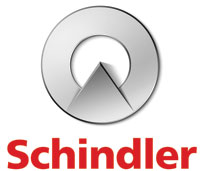 |
Schindler Elevator Corporation is the North American operation of the Switzerland-based Schindler Group. A leading global mobility provider, Schindler supports sustainable urban development with safe, reliable, and ecologically sound mobility solutions, and its equipment moves one billion people every day all over the world. www.us.schindler.com |
















